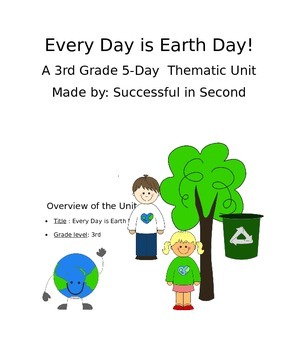Every Day is Earth Day! A 3rd Grade Thematic Unit Plan!
- Word Document File
Description
-Very detailed step by step thematic unit aligned to 3rd grade standards. Includes links to activities in TPT, photos, rubrics, books, etc.
-Use with Earth Day Power Point, Natural Resources Power Point & Earth Day Scoot in my store!
Common Core/Georgia Standards:
-ELACC3RL1 Key Ideas and Details: Ask and answer questions to demonstrate understanding of a text, referring explicitly to the text as the basis for the answers.
-ELACC3RI2 Key Ideas and Details: Determine the main idea of a text; recount the key details and explain how they support the main idea.
-ELACC3SL2 Comprehension and Collaboration: Determine the main ideas and supporting details of a text read aloud or information presented in diverse media and formats, including visually, quantitatively, and orally.
-ELACC3SL3 Comprehension and Collaboration: Ask and answer questions about information from a speaker, offering appropriate elaboration and detail.
-HE3.8: Students will demonstrate the ability to advocate for personal, family, and community health.
a. Share accurate information about a health issue.
-S3E1 The student will describe the four types of productive resources:
a. Natural (land)
b. Human (labor)
c. Capital (capital goods)
d. Entrepreneurship (used to create goods and services)
-VA3PR.3 Creates artworks based on personal experience and selected themes.
a. Creates artworks to express individual ideas, thoughts, and feelings from memory, imagination, and observation
Specific Lesson Outcomes: Write all expected outcomes that apply to your lesson. Remember to include cognitive, linguistic, and affective outcomes.
-S3L2. Students will recognize the effects of pollution and humans on the environment.
a. Explain the effects of pollution (such as littering) to the habitats of plants and animals.
b. Identify ways to protect the environment.
• Conservation of resources
• Recycling of materials
-MCC3.NBT.1 Use place value understanding to round whole numbers to the nearest 10 or 100.
-MCC3.NBT.2 Fluently add and subtract within 1000 using strategies and algorithms based on place value, properties of operations, and/or the relationship between addition and subtraction.
-ELACC3W3 Text Types and Purposes: Write narratives to develop real or imagined experiences or events using effective technique, descriptive details, and clear event sequences.
-ELACC3W4 Production and Distribution of Writing: With guidance and support from adults, produce writing in which the development and organization are appropriate to task and purpose
-MCC3.NF.1 Understand a fraction 1/b as the quantity formed by 1 part when a whole is partitioned into b equal parts; understand a fraction a/b as the quantity formed by a parts of size 1/b.
-MCC3.NF.2 Understand a fraction as a number on the number line; represent fractions on a number
line diagram.
-MCC3.NF.3 Explain equivalence of fractions in special cases, and compare fractions by reasoning about their size.





